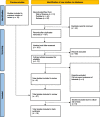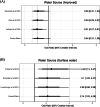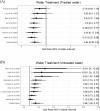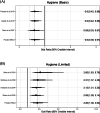Associations of water, sanitation, and hygiene with typhoid fever in case-control studies: a systematic review and meta-analysis
- PMID: 37644449
- PMCID: PMC10464135
- DOI: 10.1186/s12879-023-08452-0
Associations of water, sanitation, and hygiene with typhoid fever in case-control studies: a systematic review and meta-analysis
Abstract
Background: Water, sanitation, and hygiene (WASH) play a pivotal role in controlling typhoid fever, as it is primarily transmitted through oral-fecal pathways. Given our constrained resources, staying current with the most recent research is crucial. This ensures we remain informed about practical insights regarding effective typhoid fever control strategies across various WASH components. We conducted a systematic review and meta-analysis of case-control studies to estimate the associations of water, sanitation, and hygiene exposures with typhoid fever.
Methods: We updated the previous review conducted by Brockett et al. We included new findings published between June 2018 and October 2022 in Web of Science, Embase, and PubMed. We used the Risk of Bias in Non-Randomized Studies of Interventions (ROBINS-I) tool for risk of bias (ROB) assessment. We classified WASH exposures according to the classification provided by the WHO/UNICEF Joint Monitoring Programme for Water Supply, Sanitation, and Hygiene (JMP) update in 2015. We conducted the meta-analyses by only including studies that did not have a critical ROB in both Bayesian and frequentist random-effects models.
Results: We identified 8 new studies and analyzed 27 studies in total. Our analyses showed that while the general insights on the protective (or harmful) impact of improved (or unimproved) WASH remain the same, the pooled estimates of OR differed. Pooled estimates of limited hygiene (OR = 2.26, 95% CrI: 1.38 to 3.64), untreated water (OR = 1.96, 95% CrI: 1.28 to 3.27) and surface water (OR = 2.14, 95% CrI: 1.03 to 4.06) showed 3% increase, 18% decrease, and 16% increase, respectively, from the existing estimates. On the other hand, improved WASH reduced the odds of typhoid fever with pooled estimates for improved water source (OR = 0.54, 95% CrI: 0.31 to 1.08), basic hygiene (OR = 0.6, 95% CrI: 0.38 to 0.97) and treated water (OR = 0.54, 95% CrI: 0.36 to 0.8) showing 26% decrease, 15% increase, and 8% decrease, respectively, from the existing estimates.
Conclusions: The updated pooled estimates of ORs for the association of WASH with typhoid fever showed clear changes from the existing estimates. Our study affirms that relatively low-cost WASH strategies such as basic hygiene or water treatment can be an effective tool to provide protection against typhoid fever in addition to other resource-intensive ways to improve WASH.
Trial registration: PROSPERO 2021 CRD42021271881.
Keywords: Bayesian meta-analysis; Case-control study; Intervention strategy; Typhoid fever; Water, sanitation, and hygiene (WASH).
© 2023. BioMed Central Ltd., part of Springer Nature.
Conflict of interest statement
The authors declare that they have no competing interests.
Figures






Similar articles
-
Associations among Water, Sanitation, and Hygiene, and Food Exposures and Typhoid Fever in Case-Control Studies: A Systematic Review and Meta-Analysis.Am J Trop Med Hyg. 2020 Sep;103(3):1020-1031. doi: 10.4269/ajtmh.19-0479. Am J Trop Med Hyg. 2020. PMID: 32700668 Free PMC article.
-
Association Among Household Water, Sanitation, and Hygiene (WASH) Status and Typhoid Risk in Urban Slums: Prospective Cohort Study in Bangladesh.JMIR Public Health Surveill. 2023 Nov 20;9:e41207. doi: 10.2196/41207. JMIR Public Health Surveill. 2023. PMID: 37983081 Free PMC article.
-
Estimating Typhoid Fever Risk Associated with Lack of Access to Safe Water: A Systematic Literature Review.J Environ Public Health. 2018 Jul 4;2018:9589208. doi: 10.1155/2018/9589208. eCollection 2018. J Environ Public Health. 2018. PMID: 30174699 Free PMC article.
-
Can Existing Improvements of Water, Sanitation, and Hygiene (WASH) in Urban Slums Reduce the Burden of Typhoid Fever in These Settings?Clin Infect Dis. 2021 Jun 1;72(11):e720-e726. doi: 10.1093/cid/ciaa1429. Clin Infect Dis. 2021. PMID: 32964216
-
Prevention of Typhoid by Vi Conjugate Vaccine and Achievable Improvements in Household Water, Sanitation, and Hygiene: Evidence From a Cluster-Randomized Trial in Dhaka, Bangladesh.Clin Infect Dis. 2022 Nov 14;75(10):1681-1687. doi: 10.1093/cid/ciac289. Clin Infect Dis. 2022. PMID: 35412603 Free PMC article. Clinical Trial.
Cited by
-
Water pollution, cholera, and the role of probiotics: a comprehensive review in relation to public health in Bangladesh.Front Microbiol. 2025 Jan 14;15:1523397. doi: 10.3389/fmicb.2024.1523397. eCollection 2024. Front Microbiol. 2025. PMID: 39877756 Free PMC article. Review.
-
Field Effectiveness of a Typhoid Conjugate Vaccine: The 2018 Navi Mumbai Pediatric TCV Campaign.Am J Trop Med Hyg. 2024 Aug 13;111(4):848-852. doi: 10.4269/ajtmh.24-0181. Print 2024 Oct 2. Am J Trop Med Hyg. 2024. PMID: 39137766 Free PMC article.
-
Microarray patch vaccines for typhoid conjugate vaccines: A global cost-effectiveness analysis.Vaccine. 2025 Apr 19;53:127055. doi: 10.1016/j.vaccine.2025.127055. Epub 2025 Apr 3. Vaccine. 2025. PMID: 40184637 Free PMC article.
-
Length of hospital stay and associated treatment costs for patients with susceptible and antibiotic-resistant Salmonella infections: a systematic review and meta-analysis.BMJ Open. 2025 Jun 23;15(6):e092494. doi: 10.1136/bmjopen-2024-092494. BMJ Open. 2025. PMID: 40550720 Free PMC article.
-
Seroprevalence of Typhoid Fever and Its Associated Risk Factors Among Clinically Diagnosed Febrile Patients Visiting the Outpatient Department at Debark Hospital and Drug Susceptibility Patterns of Isolates.Biomed Res Int. 2025 Feb 1;2025:1717780. doi: 10.1155/bmri/1717780. eCollection 2025. Biomed Res Int. 2025. PMID: 39949373 Free PMC article.
References
-
- GBD 2019 Demographics Collaborators Global age-sex-specific fertility, mortality, healthy life expectancy (HALE), and population estimates in 204 countries and territories, 1950–2019: a comprehensive demographic analysis for the Global Burden of Disease Study 2019. Lancet. 2020;396(10258):1160–203. doi: 10.1016/S0140-6736(20)30977-6. - DOI - PMC - PubMed
Publication types
MeSH terms
LinkOut - more resources
Full Text Sources

